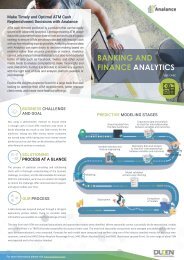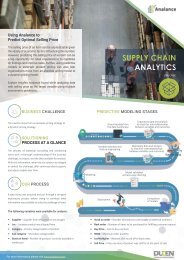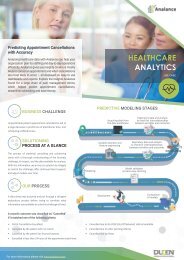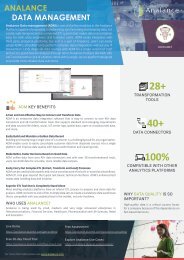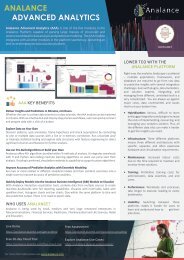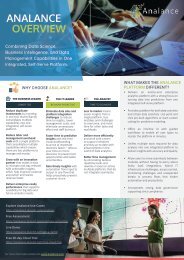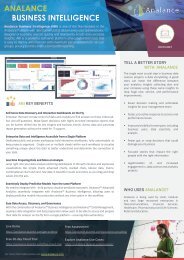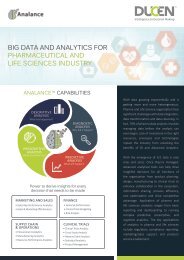Pharmaceutical and Life Sciences Sales Prediction
The Pharma and Life Sciences industry is dealing with many problems, including increased regulatory oversight, decreased R&D productivity, challenges to growth and profitability, and the impact of digitization in the value chain. https://goo.gl/yS7xeo
The Pharma and Life Sciences industry is dealing with many problems, including increased regulatory oversight, decreased R&D productivity, challenges to growth and profitability, and the impact of digitization in the value chain. https://goo.gl/yS7xeo
Create successful ePaper yourself
Turn your PDF publications into a flip-book with our unique Google optimized e-Paper software.
Track, control, <strong>and</strong> improve drug sales<br />
with Analance<br />
The Pharma <strong>and</strong> <strong>Life</strong> <strong>Sciences</strong> industry is dealing with many<br />
problems, including increased regulatory oversight, decreased<br />
R&D productivity, challenges to growth <strong>and</strong> profitability, <strong>and</strong> the<br />
impact of digitization in the value chain. On top of increasing<br />
costs for regulatory compliance, the industry is also facing<br />
rising R & D costs, changing customer demographics <strong>and</strong><br />
deteriorating health outcomes. The Pharma <strong>and</strong> <strong>Life</strong> <strong>Sciences</strong><br />
industry can use analytics to improve product pricing, sales<br />
prediction <strong>and</strong> optimization, regulatory compliance reporting,<br />
drug size <strong>and</strong> shape optimization, <strong>and</strong> more.<br />
<strong>Sales</strong> data forms the most traditional source for data analysis<br />
<strong>and</strong> analytics, with a history of contributing insights <strong>and</strong> the<br />
know-hows from marketing, sales, advertising, <strong>and</strong> other<br />
teams. Modern analytics opens the door to predict trends<br />
through more complex analysis <strong>and</strong> modeling. Data of various<br />
sizes <strong>and</strong> shapes can be analyzed to derive actionable insights<br />
<strong>and</strong> evidence based business recommendations.<br />
PHARMACEUTICAL<br />
AND LIFE SCIENCES<br />
USE CASE<br />
Explore the insights Analance found for a Pharma company<br />
that was looking to tract, control, <strong>and</strong> eventually improve sales.<br />
BUSINESS CHALLENGE<br />
AND GOAL<br />
Underst<strong>and</strong>ing sales data to forecasting sales. However,<br />
missing data created a major challenge for analysis <strong>and</strong><br />
trend reporting.<br />
PREDICTIVE MODELING STAGES<br />
Acquiring data from<br />
the data warehouse<br />
Exporatory data <strong>and</strong> analysis<br />
to check for interralationships<br />
between variables <strong>and</strong> outcomes<br />
SOLUTIONING<br />
PROCESS AT A GLANCE<br />
Variable selection <strong>and</strong><br />
feature engineering<br />
Exporatory data <strong>and</strong> analysis<br />
to check for interralationships<br />
between variables <strong>and</strong> outcomes<br />
Data cleansing<br />
The process of statistical consulting <strong>and</strong> solutioning<br />
starts with a thorough underst<strong>and</strong>ing of the business<br />
challenge, its impact, <strong>and</strong> the data available for analysis.<br />
With this information, we arrive at a solution to mitigate<br />
or control the challenge, offer continued client support,<br />
<strong>and</strong> adjust models over time.<br />
Modeling<br />
Model validation<br />
<strong>and</strong> accuracy checking<br />
OUR PROCESS<br />
A data dump was acquired <strong>and</strong> put through a stringent<br />
exploratory process before trying to correlate what<br />
information was available to solve the challenge at h<strong>and</strong>.<br />
Deployment<br />
Comparison<br />
of models<br />
ABOUT DUCEN<br />
Ducen IT helps Business <strong>and</strong> IT users of Fortune 1000 companies with advanced analytics, business intelligence <strong>and</strong><br />
data management through its unique end-to-end data science platform called Analance. Analance is an enterpriseclass,<br />
state of the art integrated platform that delivers power <strong>and</strong> ease of use to business users <strong>and</strong> data scientists<br />
with a seamless experience <strong>and</strong> platform scalability to support business growth <strong>and</strong> strategy.<br />
For more information please visit www.analance.com
THE MODELING PROCESS:<br />
AN INTRODUCTION TO TIME SERIES<br />
TIME SERIES MODELING FLOW CHART<br />
A time series model is the process of modeling serial data to find trends within<br />
<strong>and</strong>/or across the data under consideration. Every time series is composed of three<br />
components:<br />
• Trend-cycle component.<br />
• Seasonal effects.<br />
• Irregular fluctuation or error.<br />
The main assumption of time series is that data is stationary. However, techniques<br />
also exist to h<strong>and</strong>le data that is not stationary.<br />
How do we check to see if the time series is stationary or not?<br />
To underst<strong>and</strong> if the time series is stationary or not, we used the kpss (Kwiatkowski–<br />
Phillips–Schmidt–Shin), pp (Phillips-Perron), <strong>and</strong> ADF (AdjustedDickey-Fuller) tests.<br />
The tests assume that the null hypothesis of the series is stationary. A null hypothesis<br />
is a hypothesis of no predictability in the data. Subsequently, from the test results,<br />
if the lag parameter is 3 or less, the stationarity assumption can be accepted, <strong>and</strong>, if<br />
the p value is less than 0.05, the stationarity assumption can be rejected.<br />
Seasonal effects:<br />
A seasonal effect is a systematic <strong>and</strong> calendar related effect. Some examples include<br />
the sharp escalation in most Retail series which occurs around December in response<br />
to the Christmas period, or an increase in water consumption in summer due to<br />
warmer weather. An example can be seen below.<br />
Figure 2: Seasonal component visualized.<br />
THERE ARE TWO TYPES OF SEASONALITIES:<br />
AND ADDITIVE AND MULTIPLICATIVE<br />
Assuming a time series with changes in the level, the seasonal component may<br />
interact with the level in an additive or multiplicative way. This essentially means<br />
that in the first case the amplitude of the seasonality remains constant, while in the<br />
latter it changes as the level does. Figure 3 provides an example of an additively <strong>and</strong><br />
a multiplicatively seasonal time series.<br />
If the level is decreasing, under multiplicative seasonality the seasonal amplitude<br />
would get smaller while in the case of additive seasonality it would remain constant.<br />
For more information please visit www.analance.com
Figure 3. Additively <strong>and</strong> multiplicatively seasonal time series.<br />
When to apply an additive decomposition?<br />
The behaviors of the components are independent from each other. For instance, an<br />
increase in the trend-cycle will not cause an increase in the magnitude of seasonal<br />
dips <strong>and</strong> troughs. The difference of the trend <strong>and</strong> the raw data is roughly constant<br />
in similar periods of time (months, quarters, etc.) irrespective of the tendency of<br />
the trend. The pattern of seasonal variation is roughly stable over the year, i.e., the<br />
seasonal movements are approximately the same from year to year.<br />
When to apply a multiplicative decomposition?<br />
The multiplicative model is particularly appropriate if the seasonal <strong>and</strong> irregular<br />
fluctuations change in a specific manner, as a result of trend behavior. In this type<br />
of relationship, the amplitude of the seasonality increases (or decreases) with<br />
an increasing (or decreasing) trend, therefore, contrary to the additive case, the<br />
components are not independent from each other.<br />
Trends<br />
A trend is a long-term direction component of a series <strong>and</strong> is seen to either be<br />
increasing, or decreasing on a consistent basis along time. An example can be seen<br />
below.<br />
ABOUT DUCEN<br />
Figure 4. Trend component visualized.<br />
If there are multiple trends <strong>and</strong> seasonality factors, the data needs to be detrended<br />
<strong>and</strong> de-seasonalized multiple times. For data where trends <strong>and</strong> seasonality<br />
continuously persist even after de-trending or de-seasonalizing, appropriate models<br />
that accommodate trends <strong>and</strong> seasonalities are chosen for the analysis. Once the<br />
appropriate models are chosen based on the flow chart above, the analysis can<br />
either end or be reiterated.<br />
A point to note is that when the forecast residuals are correlated, <strong>and</strong>/or when<br />
there are no stark patterns or additivity seen, i.e., the data already looks stable, it is<br />
wise to take the ARIMA modeling approach.<br />
Ducen IT helps Business <strong>and</strong> IT users of Fortune 1000<br />
companies with advanced analytics, business intelligence<br />
<strong>and</strong> data management through its unique end-to-end data<br />
science platform called Analance. Analance is an enterpriseclass,<br />
state of the art integrated platform that delivers power<br />
<strong>and</strong> ease of use to business users <strong>and</strong> data scientists with<br />
a seamless experience <strong>and</strong> platform scalability to support<br />
business growth <strong>and</strong> strategy.<br />
Apart from the most commonly used decomposition schemes, there are other<br />
models describing the relationship between components. One of the most popular<br />
ones is pseudo-additive decomposition.<br />
For more information please visit www.analance.com
Pseudo – additive model:<br />
This model combines some features of both the additive <strong>and</strong> the multiplicative<br />
models. The conclusion that follows is that the pseudo-additive model assumes<br />
that seasonal <strong>and</strong> irregular components are both dependent on the trend behavior,<br />
<strong>and</strong> at the same time, are independent from each other. This model has been designed<br />
for those time series that fundamentally display multiplicative relationships<br />
between components, yet the time series may have values equal or close to zero, in<br />
which case the multiplicative decomposition cannot be applied. The pseudo-additive<br />
model allows allocation of zero values either to the seasonal or to the irregular<br />
components, leaving the trend-cycle unaffected by it. After finding the right model,<br />
the residuals are checked for correlation, <strong>and</strong>, normality with mean (arithmetic average)<br />
0, <strong>and</strong> constancy in variance by using a histogram of the residuals, passing<br />
which the model can be deployed to forecast real values.<br />
After this, the following models can be considered: ARIMA(p,d), ARI-<br />
MA(d,q), or ARIMA(p,d,q). After finding the right model, the residuals are<br />
checked for auto correlation using the Ljung-Box test with no autocorrelation<br />
as the null hypothesis, passing which, for normality with mean<br />
(Arithmetic average) 0 <strong>and</strong> constancy in variance by using a histogram<br />
of the residuals, passing which the model can be deployed to forecast<br />
real values, failing which indicates the need for other more complex time<br />
series models be considered.<br />
FINDINGS AND ANALYSIS<br />
Failing the no correlation requirement, the modeling scene switches to the ARIMA<br />
family.<br />
ARIMA models:<br />
ARIMA models: ARIMA st<strong>and</strong>s for Auto Regressive Integrated Moving Average. For<br />
fitting ARIMA models, it is important for the series to be stationary. If the series is<br />
not stationary, then the series needs to be differenced. The number of times the<br />
series is differenced contributes to the ‘d’ parameter in ARIMA(p, d), ARIMA(d, q),<br />
<strong>and</strong> ARIMA(p, d, q). Following this, the differenced series is analyzed by constructing<br />
a correlogram which looks for auto-correlation. The auto correlation function finds<br />
the parameter p if the pth serial value exceeds the confidence b<strong>and</strong>s seen below.<br />
• Analysis looked at 147 products sold over a period of 69 months.<br />
• Complete yearly data was available for 35 (24%) products.<br />
• <strong>Sales</strong> peaked in April for every product.<br />
• First <strong>and</strong> third quarter showed low sales every year <strong>and</strong> contributed<br />
to 6 months of lull.<br />
• Low sales influenced by regulatory changes were assigned a moving<br />
average.<br />
The data was segmented <strong>and</strong> analyzed based on location of each ATM.<br />
The above-mentioned findings, along with the seasonal patterns observed<br />
(strong weekly seasonality) in the dataset of each ATM, enabled<br />
us to choose the appropriate algorithm (Holt Winters with seasonal adjustments).<br />
The industry st<strong>and</strong>ard MAPE (Mean Absolute Percentage Error) was<br />
used to estimate the prediction error. A range of 50 – 60% was achieved<br />
from the data under consideration.<br />
CONCLUSION<br />
Figure 5: The auto correlation / correlogram plot.<br />
Similarly, the partial auto correlation function finds the parameter q if the qth serial<br />
value exceeds the confidence b<strong>and</strong>s as seen below.<br />
Having a model such as the one developed above can enable banks<br />
to replenish ATMs more efficiently <strong>and</strong> reduce cash redundancy in<br />
machines. The cash saved in this manner can be mobilized to offer<br />
loans <strong>and</strong> other financial services, resulting in profit/income for the<br />
banks.<br />
Time series has been found to be most effective in areas such as business<br />
or economic forecasting of events across time. A set of models<br />
has been very successful in predicting outcomes when little or no<br />
information is known about related background processes <strong>and</strong>/or<br />
features affecting the outcome. Model forecasting accuracy can be<br />
increased by adopting the regression approach if there is good quality<br />
data available, such as day of the week of withdrawal, week of the<br />
month, month of the year, dates of relevant events such as festivals<br />
or sporting events.<br />
Figure 6: The partial auto – correlation / partial correlogram plot.<br />
For more information please visit www.analance.com




